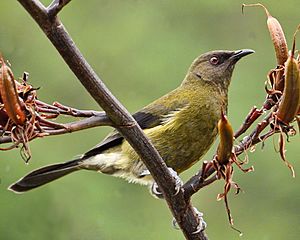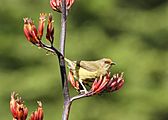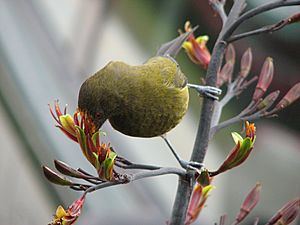New Zealand bellbird facts for kids
Quick facts for kids New Zealand bellbird |
|
|---|---|
 |
|
| In New Zealand | |
| Conservation status | |
| Scientific classification | |
| Genus: |
Anthornis
|
| Species: |
melanura
|
The New Zealand bellbird (Anthornis melanura), also known by its Māori names korimako and makomako, is a special bird found only in New Zealand. It has a greenish color and is the only living member of its group, Anthornis. The bellbird is famous for its beautiful song, which is a big part of New Zealand's amazing dawn chorus. Early European explorers loved its sound. For example, Captain Cook wrote that its song "seemed to be like small bells most exquisitely tuned." Its bell-like song is sometimes confused with the song of the tui. This bird is common across most of New Zealand, including its smaller islands and the Auckland Islands.
Contents
What the Bellbird Looks Like
Male bellbirds are olive-green with a dark purple shine on their heads and black outer wings and tails. Females are a duller olive-brown with a blue shine on their heads. They also have a yellowish-white stripe that curves from their beak to below their eye. Both males and females have bright red eyes.
Bellbirds are about 17 to 20 centimeters (about 7 to 8 inches) long, from the tip of their beak to the end of their tail. Females weigh about 25 grams (less than an ounce), and males weigh about 32 grams. Young female bellbirds have brown eyes and a light yellow stripe on their cheek. Young male bellbirds have dull brown-black outer wing and tail feathers.
Bellbird Types
There are four different types, or subspecies, of the New Zealand bellbird: A. melanura melanura, A. melanura dumerii, A. melanura oneho, and A. melanura obscura. There was once another type called the Chatham bellbird, A. melanocephala. Sadly, this bird became extinct in the early 1900s, meaning it no longer exists.
Where Bellbirds Live
Bellbirds can be found all over New Zealand's main islands, except for the very north of the North Island. Their numbers and where they live were greatly affected when European-style farming began. This led to many native forests, which are the bellbird's natural home, being cut down.
Another big problem was the arrival of new animals that hunt bellbirds or steal their food. These include cats, weasels, stoats, ferrets, and rats. These animals either eat the bellbirds themselves or their eggs. Other animals, like wasps, compete with bellbirds for their natural food sources, such as nectar, honeydew, and insects. The bellbird population went down around the same time as many other New Zealand birds. However, for reasons we don't fully understand, their numbers later grew again, and they are now common in many parts of New Zealand.
Bellbird Behavior
Reproduction
Bellbirds usually breed from September to January. During this time, a pair can have two groups of chicks. Their nesting habits are similar to the tui. They lay three to four eggs, which have pinkish-brown spots.
Diet
Bellbirds eat nectar, fruit, and insects. Insects are especially important for female bellbirds and their chicks during the breeding season. Bellbirds are honeyeaters, which means they have special brush-tipped tongues that help them sip nectar and honeydew from tree trunks. Because they visit many flowers, they help pollinate native plants like mistletoe, fuchsia, and kowhai. This means they help these plants make seeds and grow.
Song
The bellbird's song has three clear sounds that are like chiming bells. They sing throughout the day, but their songs are loudest in the early morning and late evening. Their alarm call is a series of harsh, short notes, similar to a blackbird. The unique call of the Anthornis melanura is even used by Radio New Zealand as a special sound between programs.
See also
 In Spanish: Mielero maorí para niños
In Spanish: Mielero maorí para niños






